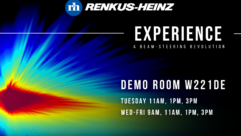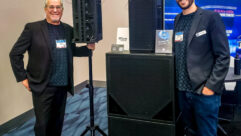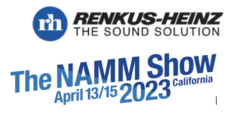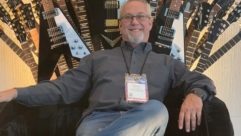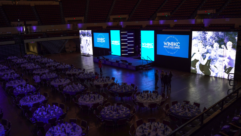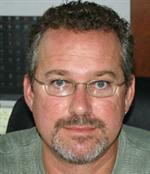

Ralph Heinz, Renkus-Heinz, on Speakers
As son of Renkus-Heinz founder Harro Heinz, you could say Ralph Heinz was born to design loudspeakers. With a background in mechanical engineering and manufacturing, he’s been the company’s principle loudspeaker designer since 1992.
Quick bio: As son of Renkus-Heinz founder Harro Heinz, you could say Ralph Heinz was born to design loudspeakers. With a background in mechanical engineering and manufacturing, he’s been the company’s principle loudspeaker designer since 1992. He developed the proprietary and patented Complex Conic and Co-Entrant waveguides and transducers. Now he’s turned his attention towards steerable line arrays and the technology in the Renkus-Heinz Iconyx series.
Ralph Heinz
Sam: The issues that loudspeaker designers address these days seem totally different from the issues just 15 or 20 years ago. Do you see, for example, self-powered and DSP-loaded loudspeakers as part of an evolutionary trend or a new direction in loudspeaker design?
Heinz: For me, it’s an evolutionary trend. I’ve always been a proponent of closely matching system electronics with transducers for optimized performance. We were among the first to offer controller-based systems and more recently controller-based amplifiers. Unfortunately, a loudspeaker enclosure, with its heat and vibration, represents one of the worst possible environments for an amplifier. It’s not until recent years that advances in class D amplification have enabled the designs of amp modules and packages that can survive reliably within a loudspeaker. As of today, we do not see total acceptance of self-powered speakers in the marketplace, though it’s growing.
Sam: With new materials and manufacturing techniques, old trends seem to have come back to play a role in the performance audio and studio monitoring worlds. For example, the use of line arrays in live sound and ribbon drivers in live and studio monitoring. Is this really a comeback or is there something new around the corner?
Heinz: Of the ribbons I’ve tested, even the units with the highest sensitivity needed 16 times the power to keep up with a compression driver. I just don’t see how they would keep up with the rest of the system. If there is something cool around the corner, I expect it will be electronic rather than transducer-based.
Sam: You’ve spent a lot of time optimizing horn designs. Have horn-loaded speakers been replaced by line arrays, particularly in large clusters? What is the future of horn-loaded arrays?
Heinz: Horn-loaded speakers have definitely lost favor for the time being. While today’s line arrays offer better performance in some aspects, say vertical pattern control and throw, they are not always the right solution for many rooms. At lower frequencies, where wavelengths are long relative to the size of the cluster, we employ electronic correction to smooth out low and mid coverage. At higher frequencies, at wavelengths where the horn is effective, we use acoustic design principles to minimize interference between adjacent cabinets. I do not think we will see a universal return to cluster-based systems, but they are still the correct solution for permanent installations in many rooms. I understand the attraction for line arrays in touring/production environments.
Sam: We share an interest in system measurement and setup. I believe system tuning is becoming more important than loudspeaker selection. Agree or disagree?
Heinz: I agree with you 110 percent. There are lots of very good sounding loudspeakers around. However, unless they are all aligned correctly as a system, the end result can be less than optimal. This is especially true in the case of our steerable Iconyx arrays, and our networkable RHAON systems. Despite their sophistication, they are dumb systems until an expert applies his experience to complete all the settings relating to coverage and system response. I enjoy being out in the field working with consultants and contractors helping optimize their systems, but I can’t be there for every installation or concert. More and more, we will have to work with and utilize additional outside resources to help ensure great results wherever our products are installed.
Sam: One of my clients’ loves this story: He arrived on site and saw two loudspeakers sitting on the stage. One was a wood-box, self-powered, 12-inch driver and horn with rigging hardware. The other was a plastic, self-powered box with a 12-inch cone and a horn. One cost him about $3,500, the other $600.00. When he asked why he paid so much more for the wooden speaker, I told him, “Because I told you to.” Do you find it’s getting harder to differentiate loudspeaker performance from box-to-box and brand-to-brand?
Heinz: There are relatively few loudspeaker manufacturers that produce their own woofers and drivers anymore. In the past, you needed expensive tooling, anechoic chambers, and an array of measurement equipment to consistently design and build good components. Today, the availability of sophisticated [computer numeric control] manufacturing equipment and inexpensive computer-based measurement systems has leveled the playing field. Whether they’re made here in the U.S. or China, in Thailand or Italy, in France or Spain, most of the drivers we all use are very good, and very similar. So product differentiation is definitely more difficult. I’ve found recently that we rely more and more on in-house electronics and networking expertise to differentiate our loudspeakers from others.
Sam: What’s the coolest loudspeaker you’ve seen this year? Does heterodyning technology get you excited?
Heinz: Heterodyning is so last year. I’m into carbon nanotube technology now (see “Get an Earful of Carbon,” PRO AV, March 2009).
Sam: Do you wish you never heard the letters DSP, or the phrase “software development?”
Heinz: If DSP and software were so easy, then everyone would be building steerable arrays. So I guess the terms make me smile and cringe at the same time.


